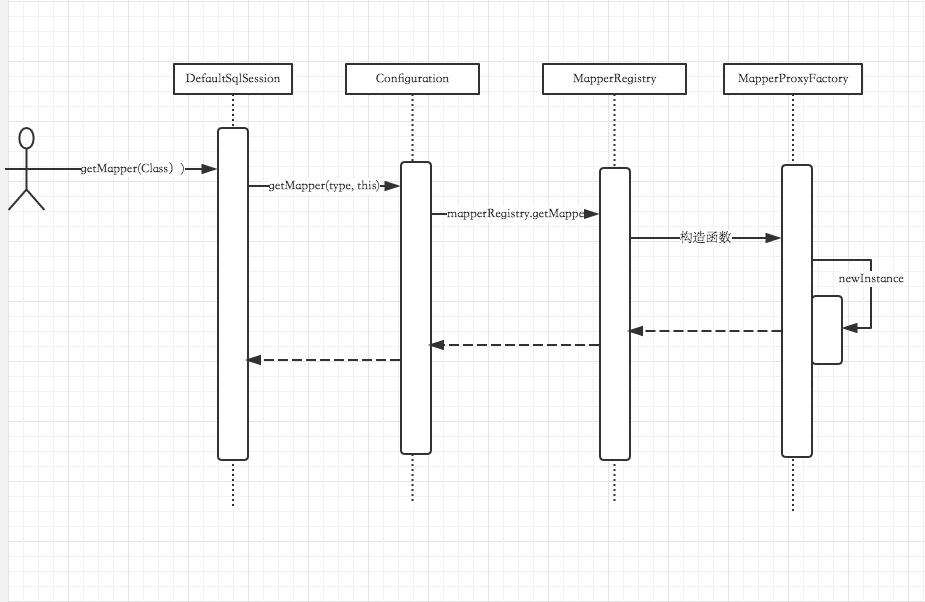上两篇已经讲解了SqlSessionFactory的创建和SqlSession创建过程。今天我们来分析myabtis的sql是如何一步一步走到Excutor。
还是之前的demo
public static void main(String[] args) throws Exception { SqlSessionFactory sessionFactory = null; String resource = "configuration.xml"; sessionFactory = new SqlSessionFactoryBuilder().build(Resources.getResourceAsReader(resource)); SqlSession sqlSession = sessionFactory.openSession(); UserMapper userMapper = sqlSession.getMapper(UserMapper.class); System.out.println(userMapper.findUserById(1)); } 我们想看下基本的时序图有个大致了解

1:DefaultSqlSession获取getMapper
@Override public T getMapper(Class type) { return configuration.getMapper(type, this); }
2:Configuration获取getMapper
public T getMapper(Class type, SqlSession sqlSession) { return mapperRegistry.getMapper(type, sqlSession); } Configuration和DefaultSqlSession什么都没有做,交给了MapperRegistry,我们看下MapperRegistry做了什么。
3:MapperRegistry获取getMapper
@SuppressWarnings("unchecked") public T getMapper(Class type, SqlSession sqlSession) { final MapperProxyFactory mapperProxyFactory = (MapperProxyFactory) knownMappers.get(type); if (mapperProxyFactory == null) { throw new BindingException("Type " + type + " is not known to the MapperRegistry."); } try { return mapperProxyFactory.newInstance(sqlSession); } catch (Exception e) { throw new BindingException("Error getting mapper instance. Cause: " + e, e); } } 通过knownMappers获取一个MapperProxyFactory,后然newInstance了一下,那么newInstance得到了什么东西呢?
4:MapperProxyFactory
@SuppressWarnings("unchecked") protected T newInstance(MapperProxy mapperProxy) { //java代理 return (T) Proxy.newProxyInstance(mapperInterface.getClassLoader(), new Class[] { mapperInterface }, mapperProxy); } public T newInstance(SqlSession sqlSession) { final MapperProxy mapperProxy = new MapperProxy(sqlSession, mapperInterface, methodCache); return newInstance(mapperProxy); }
通过以上的动态代理,咱们就可以方便地使用dao接口啦。到这里我们还没有看到任何执行sql有关的信息,或者说还没走到文章开始说的的Excutor, 我们看下MapperProxy代理类
MapperProxy
public class MapperProxy implements InvocationHandler, Serializable { private static final long serialVersionUID = -6424540398559729838L; private final SqlSession sqlSession; private final Class mapperInterface; private final Map methodCache; public MapperProxy(SqlSession sqlSession, Class mapperInterface, Map methodCache) { this.sqlSession = sqlSession; this.mapperInterface = mapperInterface; this.methodCache = methodCache; } @Override public Object invoke(Object proxy, Method method, Object[] args) throws Throwable { if (Object.class.equals(method.getDeclaringClass())) { try { return method.invoke(this, args); } catch (Throwable t) { throw ExceptionUtil.unwrapThrowable(t); } } final MapperMethod mapperMethod = cachedMapperMethod(method); return mapperMethod.execute(sqlSession, args); } private MapperMethod cachedMapperMethod(Method method) { MapperMethod mapperMethod = methodCache.get(method); if (mapperMethod == null) { mapperMethod = new MapperMethod(mapperInterface, method, sqlSession.getConfiguration()); methodCache.put(method, mapperMethod); } return mapperMethod; }} 代理类交给了mapperMethod.execute进行处理,到这里我们只是看到了execute字眼了,我们继续往下看。
public Object execute(SqlSession sqlSession, Object[] args) { Object result; if (SqlCommandType.INSERT == command.getType()) { Object param = method.convertArgsToSqlCommandParam(args); result = rowCountResult(sqlSession.insert(command.getName(), param)); } else if (SqlCommandType.UPDATE == command.getType()) { Object param = method.convertArgsToSqlCommandParam(args); result = rowCountResult(sqlSession.update(command.getName(), param)); } else if (SqlCommandType.DELETE == command.getType()) { Object param = method.convertArgsToSqlCommandParam(args); result = rowCountResult(sqlSession.delete(command.getName(), param)); } else if (SqlCommandType.SELECT == command.getType()) { if (method.returnsVoid() && method.hasResultHandler()) { executeWithResultHandler(sqlSession, args); result = null; } else if (method.returnsMany()) { result = executeForMany(sqlSession, args); } else if (method.returnsMap()) { result = executeForMap(sqlSession, args); } else if (method.returnsCursor()) { result = executeForCursor(sqlSession, args); } else { Object param = method.convertArgsToSqlCommandParam(args); result = sqlSession.selectOne(command.getName(), param); } } else if (SqlCommandType.FLUSH == command.getType()) { result = sqlSession.flushStatements(); } else { throw new BindingException("Unknown execution method for: " + command.getName()); } if (result == null && method.getReturnType().isPrimitive() && !method.returnsVoid()) { throw new BindingException("Mapper method '" + command.getName() + " attempted to return null from a method with a primitive return type (" + method.getReturnType() + ")."); } return result; } 上面代码先是判断CRUD类型,然后根据类型去选择到底执行sqlSession中的哪个方法,我们现在是查询那么程序应该走到sqlSession.selectOne。
@Override public T selectOne(String statement, Object parameter) { // Popular vote was to return null on 0 results and throw exception on too many. List list = this.selectList(statement, parameter); if (list.size() == 1) { return list.get(0); } else if (list.size() > 1) { throw new TooManyResultsException("Expected one result (or null) to be returned by selectOne(), but found: " + list.size()); } else { return null; } }
@Override public List selectList(String statement, Object parameter, RowBounds rowBounds) { try { MappedStatement ms = configuration.getMappedStatement(statement); //终于看到我们要找的executor接口了 return executor.query(ms, wrapCollection(parameter), rowBounds, Executor.NO_RESULT_HANDLER); } catch (Exception e) { throw ExceptionFactory.wrapException("Error querying database. Cause: " + e, e); } finally { ErrorContext.instance().reset(); } } 我们终于看到executor类了, 调用了query方法,接下来的事情全部交给了executor处理了,
executor底层的分析已经在上一篇已经分享了。
我们代理执行sql的基本顺序是
MapperMethod.execute() --> DefaultSqlSession.selectOne --> BaseExecutor.query --> SimpleExecutor.doQuery --> SimpleStatementHandler.query --> DefaultResultSetHandler.handleResultSets(Statement stmt) 最终得到数据。